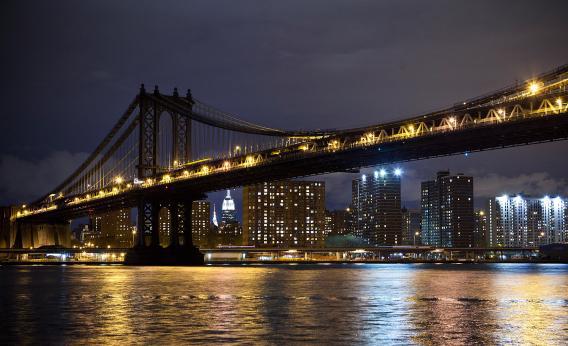Superstorm Sandy rocked the Rockaways, flattened parts of Staten Island, and brought Lower Manhattan to its knees. Now two of those regions remain mired in mud and misery. But the third is springing back to life.
As I write this, I’m on a crammed city bus crawling uptown through the blacked-out Financial District. Blackouts in Manhattan used to mean nights of terror. But the mood here isn’t chaotic. If anything, it’s tinged with anticipation and relief. Neighborhood by neighborhood, the power is coming back. By the end of Saturday, Con Edison expects to have electricity flowing to the whole island.
As the lights flick on, they will reveal a city bruised but essentially intact. It will look almost as if everyone had power all along. And in a way, they did.
I walked today from Midtown to the island’s southern tip, took the East River Ferry to Brooklyn, walked back across the darkened Brooklyn Bridge, and waited in the cold blackness for the bus back uptown. The electricity was out, yet everywhere there were people in the streets, going about their business. Sure, many had fled to comfier digs in other parts of the city. But others stayed and jerry-rigged ways to keep their food hot, their phones charged, and even, in some cases, their credit-card readers running. In many cases it was the private sector that provided essential services.
On Broadway in the Flatiron district, the high-end retail chains were mostly shuttered, their windows still sporting closure notices from the day the storm blew in. But an independently owned kitchen supply shop called Whisk was open, candles flickering invitingly within. Owner Natasha Amott told me she had reopened Wednesday morning. Originally, she accepted cash only, but with most ATMs out of order, cash was scarce. Undaunted, she and her team figured out a way to tap into their point-of-sale system via a mobile app. (The storm took out cell service in some neighborhoods, but on the whole the city’s wireless service fared far better than its power grid.) By Wednesday evening they were taking credit cards and selling candles by the hundreds.
At Broadway and 19th, Fishs Eddy was closed, but its windows served as a community message board, plastered with post-it notes addressed to Sandy.
Union Square became a depot for utility trucks. But it was the food trucks that lit up resident’s faces. They had two big advantages over brick-and-mortar restaurants: built-in generators to keep the power running, and wheels to get to where the hungry people were. This Empanada truck also snaked an extension cord from its generator to let passersby charge their laptops.
Angelo Farrugia, superintendent of an office building on Union Square, fixed up a tenant’s generator, borrowed gas from a nearby taco truck, and set up an ad hoc charging station outside his building’s front door.
Chase installed portable, generator-powered ATMs.
I happened to be walking down Little Italy’s commercial main drag, Mulberry Street, when the lights buzzed to life there. A man outside a restaurant whooped and the customers inside toasted and cheered. A young boy sprinted down the sidewalk in glee. And a jubilant old woman opened her second-story window, leaned out, and began banging on a pot.
Farther south, a work crew took a break from cleaning a flooded office building on Water Street in the Financial District.
I saw just one smashed window in the city—on a BMW that had floated onto the sidewalk in the Financial District.
Perhaps the most depressing place in Lower Manhattan on Friday: the Staten Island Ferry building. It was so deserted that I had to ask a security guard whether it was really open. He confirmed that it was. But even those affected by the Manhattan blackout seemed to know that things were much worse on Staten Island. Most of the traffic was in the other direction.
